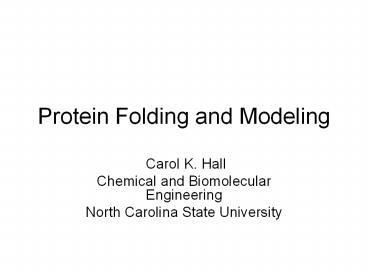Protein Folding and Modeling - PowerPoint PPT Presentation
1 / 23
Title:
Protein Folding and Modeling
Description:
Assumes that proteins with similar sequences have similar structures, ... Folding of Villin Headpiece Subdomain. Well-studied, fast-folding 36-residue protein ... – PowerPoint PPT presentation
Number of Views:191
Avg rating:3.0/5.0
Title: Protein Folding and Modeling
1
Protein Folding and Modeling
- Carol K. Hall
- Chemical and Biomolecular Engineering
- North Carolina State University
2
Computational Methods for Modeling Protein
Folding and Structure
- 1. Homology Modeling
- Assumes that proteins with similar sequences have
similar structures, alignments - 2. Threading
- Threads sequence of unknown structure through
database of known structures and scores match
based on contact potentials - 3. Ab initio or de novo approaches
- Deduce 3-d structure for given sequence by
finding minimum energy based on force field
3
Types of Computer Simulations
- Molecular Dynamics
- Decide on model intermolecular forces
- Distribute 500-100,000 molecules in simulation
cell assigning random positions and velocities to
each molecule - Monitor molecules motion as a function of time
by solving Newtons equation of motion (Fma) at
each time step to predict new position and
velocity - Take time averages of properties of interest
- Monte Carlo
- Decide on model intermolecular forces
- Distribute 500-10,000 molecules at random
locations in cell - Generate configurations of these molecules
randomly (in proportion to their probability of
occurring) - Take averages over all configurations generated
to calculate properties of interest
4
Types of Computer Simulations cont.
- Periodic Boundary Conditions makes 1000
molecules look like 1023 molecules - Computer simulation gives exact results for the
molecular model studied
5
(No Transcript)
6
Simulation of a System of Hard Spheres
7
(No Transcript)
8
(No Transcript)
9
(No Transcript)
10
Folding Kinetics
New View Energy Bias
Dill Chan (1997)
11
Representing Protein Geometry
- Atomic Resolution Models
- Each atom on protein and on solvent molecules is
represented as a sphere interacting via a
realistic set of potentials based on the Lennard
Jones potential and electrostatic Coulomb
potential - Includes correct bond lengths, bond angles,
planar trans peptide bond, leads to faithful
representation of protein geometry. - Low resolution models ( Coarse-grained or
Simplified Folding Models) - Solvent molecules not included in the
simulation. - Lattice Models protein is chain of
single-site amino acid residues arranged on the
sites of a square or cubic lattice - Off-Lattice models protein is a flexible chain
of single-sphere amino acid residues interacting
via Lennard Jones or other potentials - Intermediate Resolution Models in between
12
All-Atom Simulations
13
Folding of Villin Headpiece Subdomain
- Well-studied, fast-folding 36-residue protein
- Folding time is 10 microseconds
- Duan and Kollman (1998) conducted a 1-
microsecond simulation of folding using 256
dedicated CPU for 2 months - Unfolded state? hydrophobic collapse ?helix
formation ? conformational readjustment?
partially-folded intermediate
14
(No Transcript)
15
All-atom simulations
16
Folding of Polyalanine 30-mer
17
Villin Headpiece Folds at Home
18
Intermolecular Potentials for Spherical
MoleculesOne Example Lennard Jones Potential
- Lennard-Jones potential in dimensionless form
- r r/ s where s is molecular diameter of system
under study
taken from Dr. D. A. Kofkes lectures on
Molecular Simulation, SUNY Buffalo http//www.eng.
buffalo.edu/kofke/ce530/index.html
19
Why use simplified ( coarse-grained) protein
models?
- All atom simulations take too long, can depend
sensitively on the details, and sample only very
early folding events. - Simplified models allow us to learn general
physical principles of protein folding. contain
few parameters ,implicit biases. - Allow complete exploration of conformational and
sequence space
20
(No Transcript)
21
Lattice Models for Folding Monte
Carlo Simulations
- Amino acid residues are sites ( beads) on a
cubic lattice - Generate random moves of beads on the lattice
protein - Accept moves based on their
- probability of occurring exp( Enew-E
old)/kT
(2)
(1)
(3)
(4)
22
Lattice Models -The HP Model
- Energy function amino acids are either
hydrophobic (H) or polar(P), - Hydrophobic beads, H, attract each other with
strength e when they are on neighboring lattice
sites - U e number H-H contacts
23
Lattice model of folding
1016 possible starting configurations
Q0 of native contacts C total of
contacts F free energy 1016 possible starting
conformations rapidly fold to one of 1010
disordered globules and then slowly search for
one of 103 compact transition states that rapidly
fold to the unique native structure.
1010 disordered globules
F
Q0
C
103 transition states
1 native configuration































